Scott R. Stroud
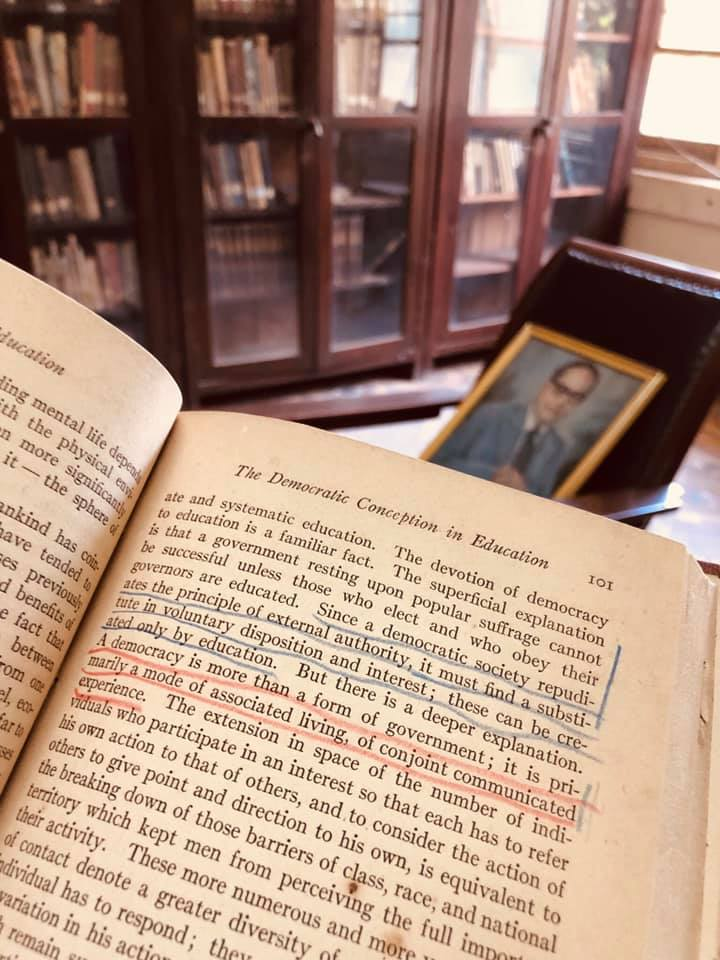
Everyone who knows Bhimrao Ambedkar surely knows that he was a voracious reader. His personal library was a wonderful aberration in a time when books in private hands were fairly rare, not to mention the prevailing situations when those hands were labeled as “untouchable” by the oppressive customs of caste. His library at the time of his death in December 1956 was reputed to be around 50,000 volumes. Significant portions of this library were donated to the colleges he started, Siddharth College in Mumbai and Milind College in Aurangabad, for their general collections.
As Ambedkar has become a figure of more advanced study, many of these books have been removed from general circulation and moved to special collections in these libraries to preserve them. The books that bear his signatures (often from his days at Columbia University 1913-1916) and personal markings are especially important to preserve. As I have discovered while perusing the general stacks of Siddharth College, not all of these books have been identified and archived. Some, like this book on Marx authored by John Dewey’s student, Sidney Hook, seemed to come from Ambedkar’s collection; it appears to have been donated for college use. Before one could consider how Hook played an important part in the story of Ambedkar and American pragmatism, one may ask: How do I know Ambedkar held this book? According to its check-out card, Ambedkar was its authorized library user from 1953 to 1956.
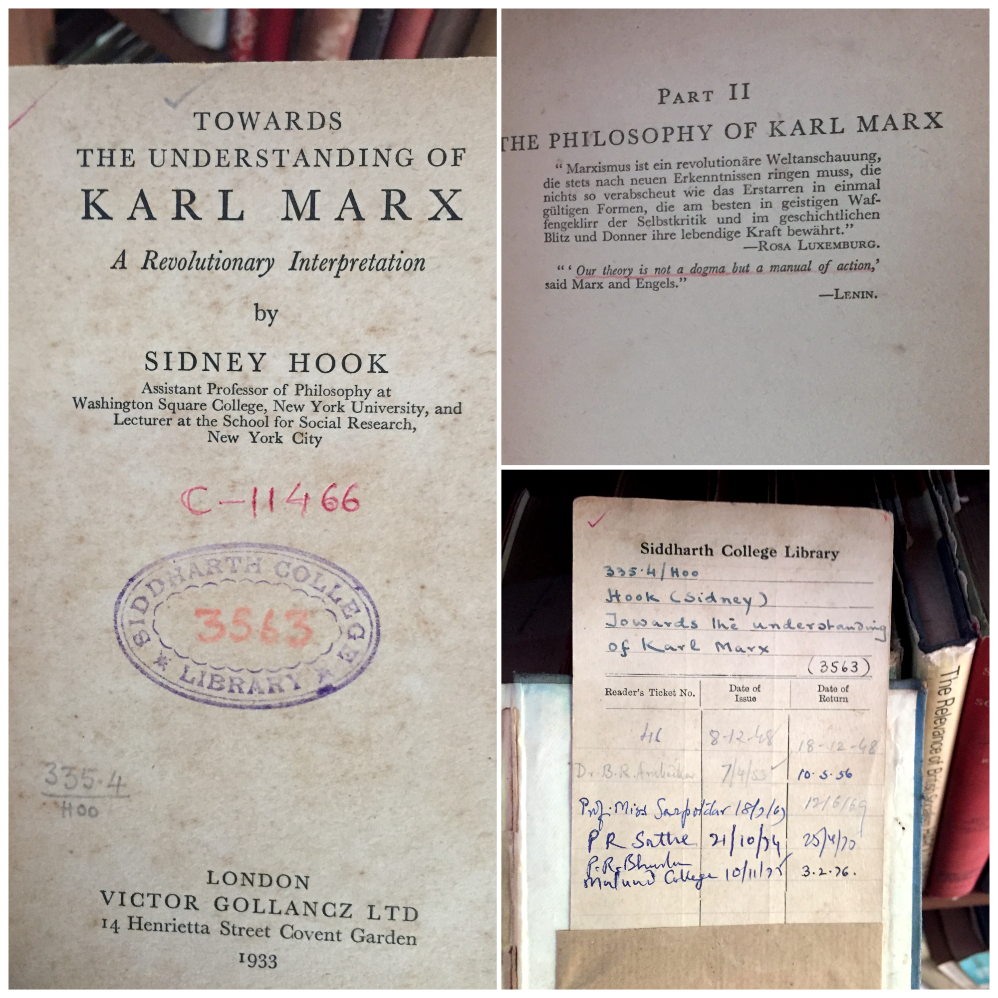
But, if you preserve a sense of doubt for a bit longer, you can ask—how do we know that he read it or thought deeply about its contents? This is a tougher question to honestly answer. My intuitive response, the one that initially led me to give this book to the special collections librarians as a work that should be preserved, was this: it contained what I know as his characteristic pencil annotations (usually in red or blue, and occasionally in grey). This clue has led me to identify other books circulating among students that surely come from Ambedkar’s own collection, like this 1937 copy of Vladimir Simkhovitch’s Toward the Understanding of Jesus, a book that lacks any signature by Ambedkar (or information on its check-out card). This old book caught my eye since Simkhovitch was a teacher of five courses that Ambedkar took at Columbia University between 1913 and 1916.
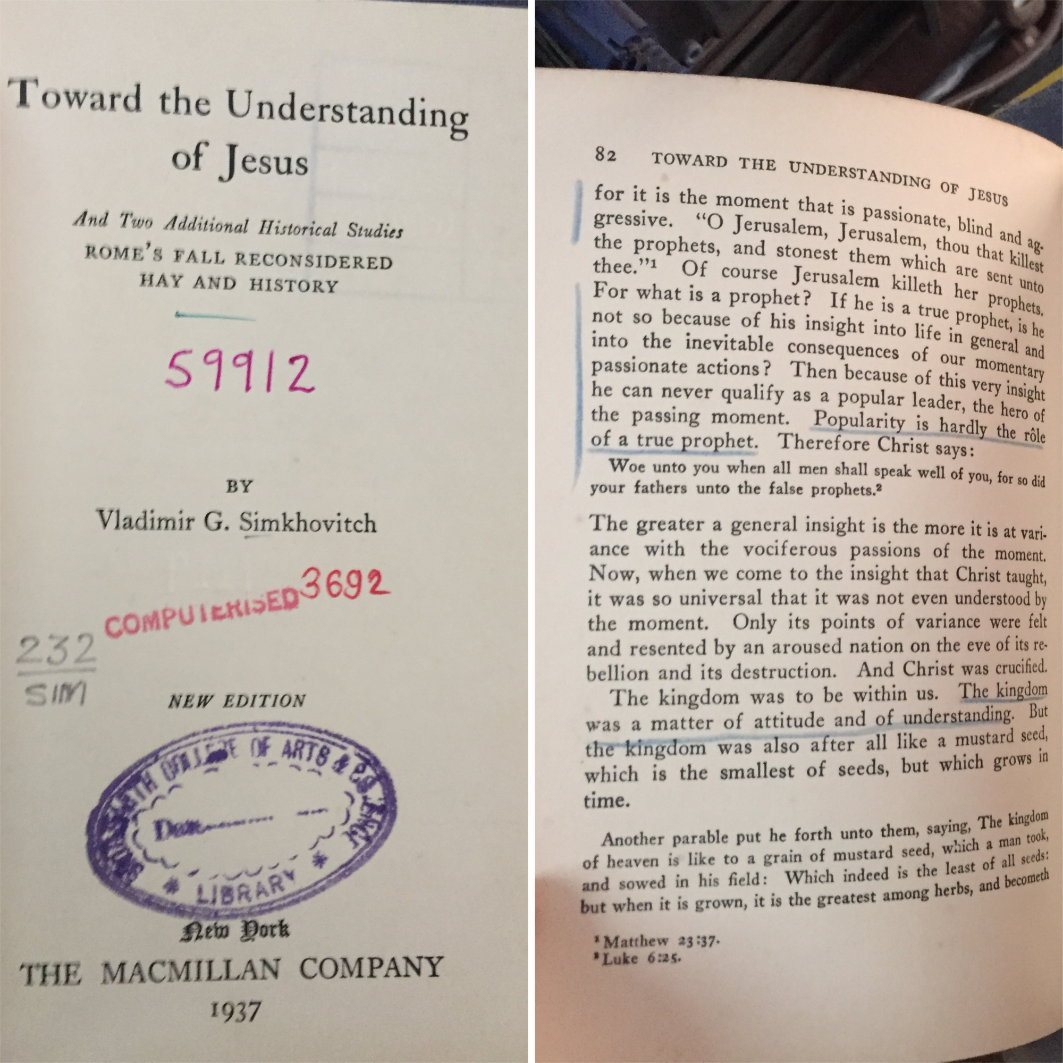
As is evidenced by Hook’s book on Marx, however, these texts have been in other hands. The Marx book had clearly been checked out for years after it was in Ambedkar’s possession. The Simkhovitch book wasn’t clearly tied to Ambedkar’s use other than its markings. Others might have held it or even marked in it in the decades after his death. All of this pushed me to consider a question that I hadn’t really thought of: how would one prove to a skeptic that these are Ambedkar’s markings? What sort of evidence would you present that ties these marks and these styles of annotations to Ambedkar’s own practices? The markings themselves aren’t the best sort of evidence for such a query since their provenance and history is what was in question.
The “Rosetta Stone” for Ambedkar’s Annotations
The answer to these questions came when I stumbled across another annotated book, this one preserved in the “Ambedkar Collection” in a special room in Siddarth College’s library. They keep thousands of Ambedkar’s personal books in this collection, and many bear his markings and a few bear his signature. It was there that I beheld a 1900 edition of The Institutes of Vishnu from F. Max Müller’s “Sacred Books of the East” series. This book was a dharma shastra that spoke about caste, so it was obviously an important book for Ambedkar’s scholarship. But for me, it was what was inside the front cover that was so useful.
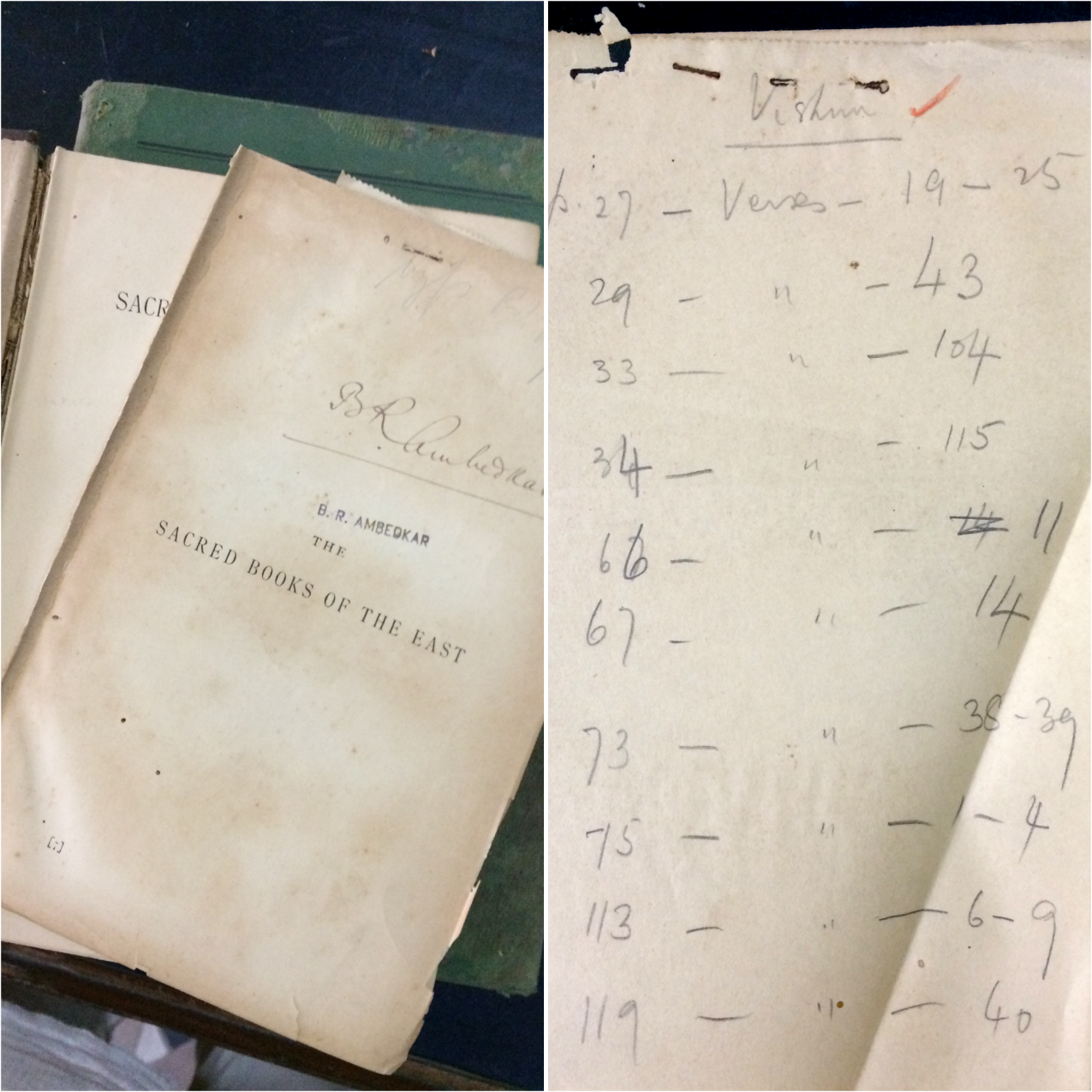
Attached to the flyleaf page by a rusty iron pin was a collection of small blank papers. The page to which they had been attached held Ambedkar’s signature from later in his life, most likely in the 1930s or 1940s. In his handwriting, Ambedkar had covered these blank pages with page and verse numbers.
Eventually, it dawned on me the importance of this discovery. Looking at these notes and the markings in the book itself, one can clearly see the specified verses marked. Beyond this, one could see that the noted verses were marked in what I’ve taken to be his characteristic styles. For instance, on page 29 you can see the specified verse concerning caste marked in a characteristic blue marginal line.
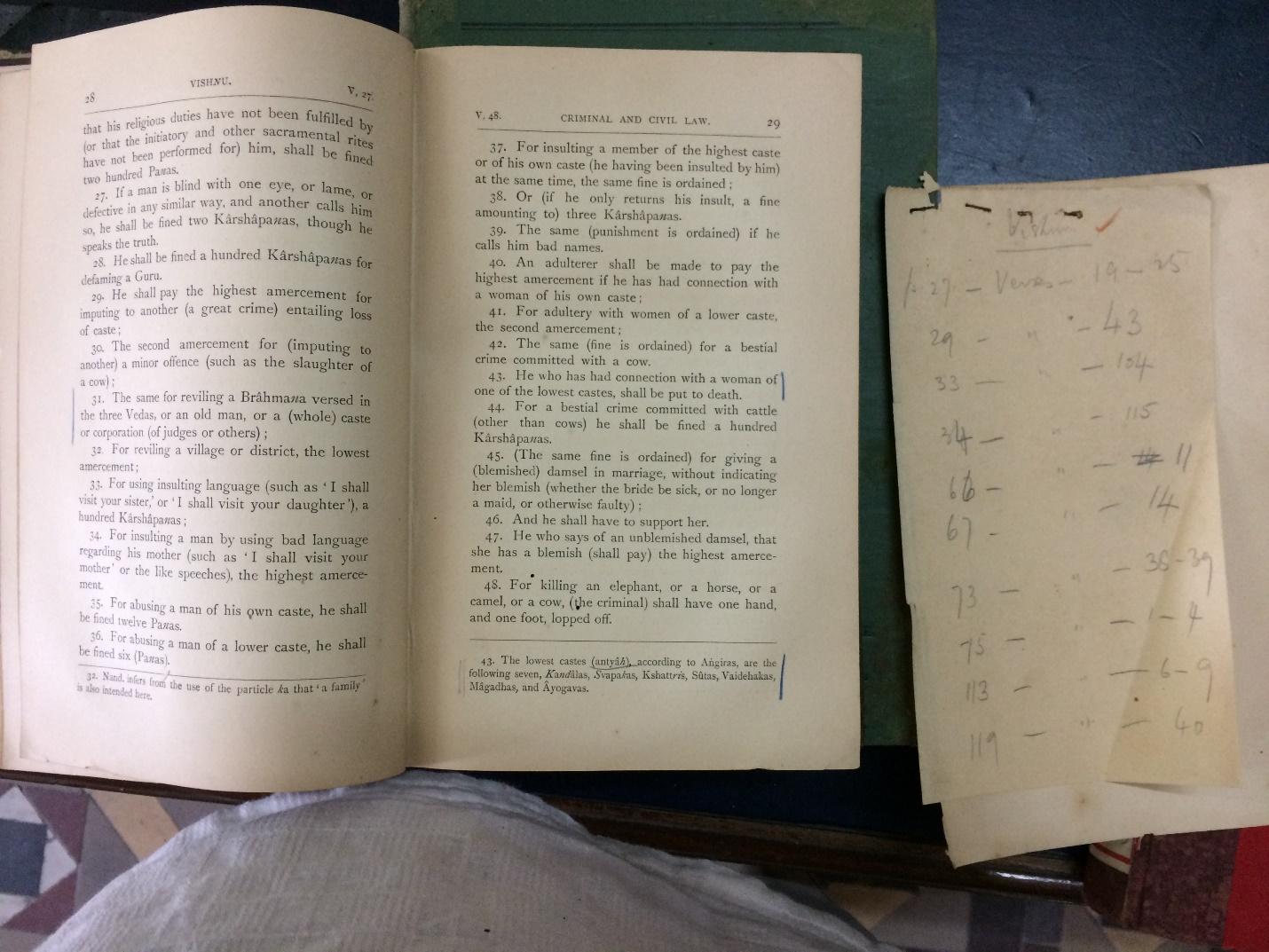
Next to verses on other denoted pages, one can observe the grey marginal double pencil lines that adorn other books owned by Ambedkar.
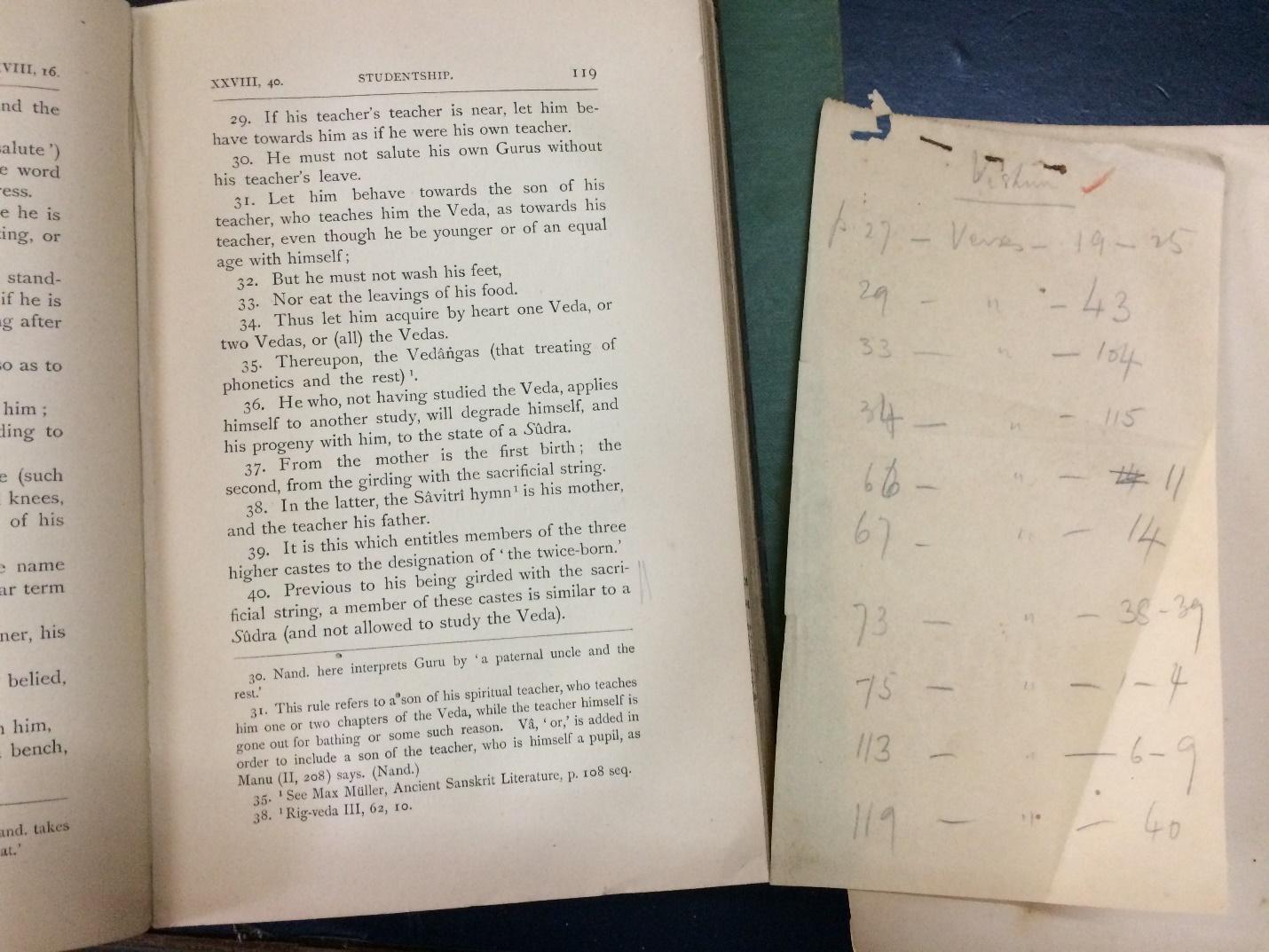
You even see a blue marginal line covering all four verses that Ambedkar listed as of interest on page 113 in the pinned index sheets written in his own hand. There are even check marks in red pencil on the note pages and in the book’s text.
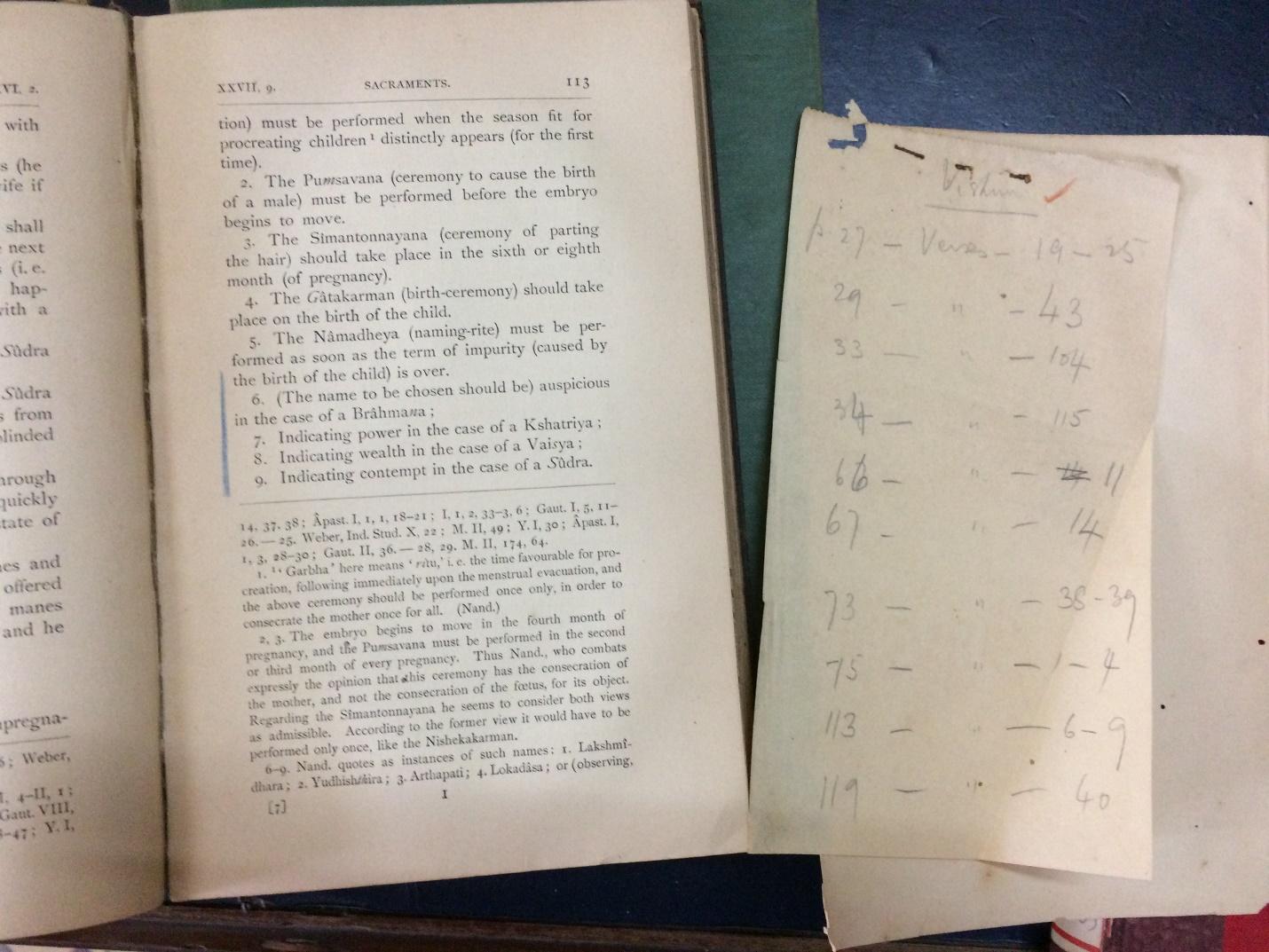
What’s the importance of all these correspondences between page and verse notations and textual marks? These may seem like minor observations, but they serve as a sort of Rosetta stone of verification for what we take as his common annotation styles. Because of the correspondences contained in its three passages of identical texts, the Rosetta stone enabled modern scholars to translate two unknown scripts (Ancient Egyptian hieroglyphic and demotic) from a known language (ancient Greek). While Ambedkar’s notes and personal book do not open up anything as drastic as did the new understanding of ancient Egyptian languages, this combination of signed handwritten notes and annotated text does allow us to connect certain styles of marking with a specific person—Ambedkar.
It shows beyond much doubt that Ambedkar created this index note sheet that bore his signature, and that he marked this book in these styles on those pages. It also gives one support for the inference that the presence of these styles of annotation elsewhere in other books can likewise be taken to be his markings—and not the markings of other readers who borrowed or used the books during and after his lifetime. This may seem to be a small point, but pushing the scholarship of Ambedkar’s complex life and work requires us to support and flesh out as many of our assumptions and speculations about him as possible. That also includes what we think we know about his reading habits.
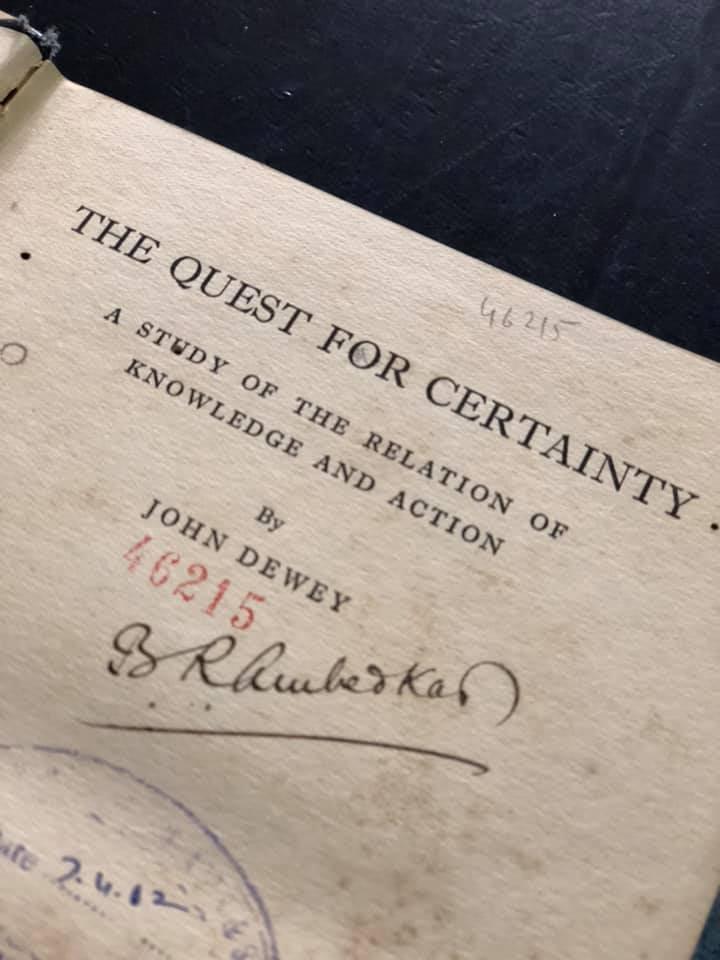
Why Do Ambedkar’s Annotations Matter?
Annotations or markings inside a book are a material trace of one’s engagement with it. We assume that if one had a book, or perhaps even mentioned a book, that one actually read the entire book.
We also assume that if a person read a book, they absorbed all of it. But these are all highly questionable assumptions and inferences. We know of books that we don’t own, we own books that we don’t read, we read books cover-to-cover and don’t think highly of their contents, and we can read parts of a book that seem to be of use for what we are currently engaged in. All of this shows the complexity and nuance involved in understanding Ambedkar’s practices of reading and his reception of the ideas of others.
I have argued elsewhere that we often get content with speculation and do not seek to find evidence of what exactly Ambedkar heard in his classes or during his education; the same applies to many of our approaches to Ambedkar as a widely-read scholar and thinker. For instance, a fellow scholar of Ambedkar, Jadumani Mahanand, told me that Ambedkar surely read John Dewey’s The Public and Its Problems (1927), due to its argumentative parallels with some of Ambedkar’s later works. My excitement about such a claim was quickly calmed when I approached it with the demeanor of a skeptic—what evidence do we have for such a claim being historically accurate, beyond arguments pointing in a vaguely similar way? Did Ambedkar clearly quote or cite this Dewey book in his any of his books or shorter works? What evidence do we have that he read it—are there any surviving note cards showing that he contemplated its contents? Did he own this book, even if he did not read or annotate it? For instance, does a copy survive in the thousands of books we have from Ambedkar’s collection? Sadly, no evidence exists that points toward him owning, reading, or engaging with a copy of Dewey’s 1927 book, The Public and Its Problems. This impressed on me the following lesson: We must carefully engage the historical questions of Ambedkar’s broad education, both during his formal experiences at various universities and in his informal reading experiences later, with as much rigor as possible. Why don’t we search for the best evidence we can to flesh out such an important and complicated figure as Babasaheb?
Time erases so much. We do not know with exhaustive certainty what passages Ambedkar read and thought about, but annotations and textual markings can give us some of the best insight now possible into these vexing questions. As H. J. Jackson argues, markings and “marginalia are the product of an interaction between text and reader carried on—since books are durable objects—in the presence of silent witnesses.” Readers make these marks for some purpose, and they reside as material reminders for us of this act of textual engagement. They can serve as “clues to the identity of the writer” and as something akin to “‘access to the inner life’” of the reader in question.
Ambedkar’s marks are waiting for us to hear their silent witness of his activity as a reader. In the thousands of books from Ambedkar’s personal library preserved in various locations such as Siddharth College in Mumbai, the Symbiosis Institute in Pune, Milind College in Aurangabad, Rajgraha in Mumbai, and various private collections, many remain with Ambedkar’s distinctive styles of annotating and marking texts with his gray, blue, or red pencils. These are clues waiting for us to use them. Christopher Queen put the importance of these marks succinctly: “Ambedkar’s habit of marking and annotating the texts he wished to consider most deeply offers us a rare opportunity to witness his way of entering into dialogue with the great thinkers of the past.” Through the material objects of his books, we can gain added access to what books and ideas he was actually reading and engaging.
Our assumptions about his patterns of engagement are often up for questioning. He was a busy leader and activist, as well as a scholar, and could not read everything he wanted to read—or everything he owned. We see hints of this habit shine through in the recollections of his closest personal assistants. Devi Dayal, Ambedkar’s personal assistant from 1943 to 1951 and the caretaker of Ambedkar’s precious book collection, recalls Ambedkar saying that “It is my childhood habit. I must have a pen or pencil in my hand while reading a book. When I come across an important para[graph], sentence, or phrase, I note it down.” Dayal continues: “Besides writing on the notebooks, he marked or underlined an important para[graph] or sentence in a book with a pencil…It was in Babasaheb’s habit to read the para[graph]s marked, or written on the notebooks in his leisure time. Thus, he refreshed his extraordinary intelligence. It was his childhood habit, inculcated to remember something.”
We can see that what Ambedkar marked was of special importance. These markings were a clear sign of what materials he read, what he saw as important while reading, and what he marked as worthy of returning to in a future reading session. We also see that just because he referred to a book in his writings, or if he owned a book, we may be on shaky ground claiming that he read and absorbed all of it. He was much more selective and purposive (not to mention busy) than those assumptions speculate.
Ambedkar as Pragmatic Reader
His markings are vital in many ways to actually knowing what we think we know about this thinker. But is there some sort of code to the meaning of his marks? I have not been able to discern any pattern in the colors of his markings—red does not mean disagreement or other such clear things. After chatting with Anandraj Ambedkar and Vijay Surwade about Ambedkar’s library and reading habits, I am convinced that the different colors of annotations simply denote the types of pencils that happened to be at the table he chose during a specific reading session. No pattern emerges to explain his marks otherwise.
But this quotidian fact can show us something of importance, if we are open to thinking more about it. It can give us new insight into the relative importance of a book and a passage. Some texts, like this vital passage from John Dewey’s 1916 Democracy and Education that discerning readers can spot echoed in a few parts of Ambedkar’s collected works, were clearly read at least three separate times, judging from the different types of annotations and pencils used.

Ambedkar’s love for pragmatism did not stop with this one book of Dewey’s. The ideas, ideals, and methods inherent in pragmatism seeped into Ambedkar’s own creative ways of building his own philosophy. For instance, pragmatism’s reconstructive urge and valuing of tentative usefulness over supposedly more “permanent” values can be seen in Ambedkar’s own reading habits. He read books like a pragmatist should. He had his own purpose and always had an eye on how an author’s text might be bent to his own struggles. He once told U. R. Rao, a manager for the publisher Thacker & Company, that reading an entire book is
seldom my style of reading. There are only a few books which call for deep study, from cover to cover. When I see a new title on a subject I am interested in, say socialism, I glance through the blurb, the introduction, the contents, decide which chapters would probably offer me some new thoughts and ideas on the subject. And then I read only those pages, for the rest is familiar ground. And when I have done that, you may say I have read the book.
Pragmatism was all about purposive action in an uncertain world, a world without timeless touchstones that gave us the security of certainty. Ambedkar had unwavering commitments—to eradicating caste oppression and promoting democracy as a way of life—but he also recognized this temporariness to any state of affairs and the relativity of activities to specific goals and purposes. This was as it should be, for he was both a Buddhist and a pragmatist, and both of these approaches enshrine a respect for constructive activity in a world of change and instability. To know him even more in all his creative power, we need to examine every source of information we have. His annotations, if given all the meaning they might possess, are one very important vector of meaning behind such an epochal thinker and leader.
The author would like to thank the dedicated librarians of Siddharth College, especially Shrikant Talvatkar and Chaitali Sonawane, for sharing their enthusiasm for and knowledge of Ambedkar’s personal books.
~~~
Scott R. Stroud is a professor of communication studies at the University of Texas at Austin. He is the author of The Evolution of Pragmatism in India (HarperCollins India / University of Chicago Press, 2023) and co-founder of the first “Center for John Dewey Studies” in India at Savitribai Phule Pune University. He also serves as the Program Director of Media Ethics at the Center for Media Engagement.










